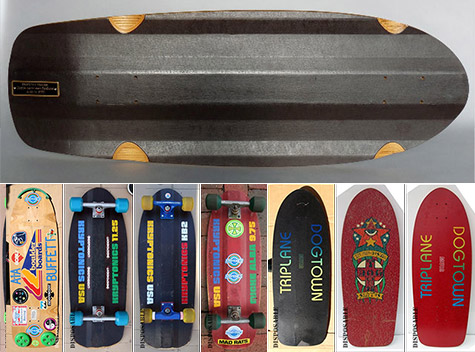
Disposable: A history of boulder boards
This has been stated so many times before that I don’t even know how to say it any other way now, but my primary impetus for beginning work on what would eventually become The Disposable Skateboard Bible was to tie up a few loose ends that I wasn’t able to find or include in the first book—several of which were only made possible in the years following its publication. For this reason perhaps that’s why I dragged my feet for two and a half years to compile material for the Bible, because just when I was about to theoretically call it done I would inevitably find one more board or story to follow up on, e.g. the random time I met Rich Harbour’s daughter at a backyard Banta party. I could have gone on indefinitely in this manner had I not finally committed to a delivery date with the publisher in April 2009, and it was an oddly bittersweet moment to at long last say, “It is finished.” Not only that but I kind of felt like a dink for calling it the “Bible” when I knew there were still a few outstanding historical pieces to the puzzle. Seriously, God left Himself a really, really big loophole with that ambiguous book of Revelations.
One of the ways in which the The Disposable Skateboard Bible differs from its predecessor is that on occasion it does stray beyond the graphic norm and delve into the more specialized arena of board construction. This happened in the ’70s gallery a few times; not only because there wasn’t a whole lot graphically going on then but it was a period of fast and furious innovation right up until the early ’80s when 7-plies of Canadian hard rock maple became standard manufacturing procedure, give or take the occasional epoxy, fiberglass, foam, or titanium deviation. One of the more interesting companies that I’d hoped to provide a bit more manufacturing insight on was Boulder Boards, but most all of my half-assed efforts to find out something of a historical nature fell short. None of the people I contacted could recall much of anything and the online trail eventually went cold, the book went to print, end of uneventful story.
A week ago though, an auction* appeared on eBay for the “original master prototype of the last and only unreleased version of the K Beam Series, the Tri-Beam.” The board was cool and all, but the real gem for nerds like me was the auction description itself: a full blown history of Boulder Boards. Once upon a time this would have been the type of thing to make me take pause and go, Hmmm … do I dare take a piss on everyone that has already purchased the book and make a few revisions? but rest assured I won’t be doing that. Especially since I have this little online blooger to pick every now and then. That said, reprinted here is a more pictorially fleshed-out version of the Boulder Boards story, as written by Scott Peck.
A BRIEF WINDOW OF SKATEBOARD HISTORY: Boulder Boards and the Kryptonics K Beam
My name is Scott Peck. I was the functional general partner of a company called Boulder Boards that formed in 1977 in Boulder, Colorado. Besides having responsibility for the actual manufacturing plant, I was also entirely responsible for the design and engineering for the skateboards we produced into 1980.
At that time the market was beginning to mature and boom. Dogtown had already taken boards to new wider widths and the up-and-coming pros were taking pool riding to incredible new heights.
Skateboards themselves, however, were still fairly heavy, quite breakable, and often had poor longevity. From my point of view, a skateboard was simply a wood manufacturing industry’s variation of a curved chair back and it was being built exactly the same way. The problem was chair backs weren’t meant to withstand the rigors of crazy and gymnastic skateboard riders.
1978:
I had no previous experience with skateboarding. My career up to that point had been based on fine woodworking. Once I got up to speed with the challenges of building good decks and spending a significant amount of time with numerous riders at the local Boulder skate park, we introduced the first Boulder Boards line in 1978. That line reflected the benefits of completely re-engineered high-tolerance Radio Frequency dies, a much more expensive and resilient adhesive, and tapered wheel-wells that actually matched truck geometry. A lab in California found my first board to be the strongest deck for its weight that it had ever tested, but the board had no reputation, no associated pro, and what made the board better could not be easily seen. Worse, it looked just like a simple variation of every other company’s product.
Looking to use it as an example for generating OEM business for our small plant, I took it to California where Variflex started to use us. Sims turned me down, a move they later regretted.
In the meantime, Kryptonics, located literally down the road from us, was making wheels that were undeniably hot and promoting a composite, non-wood board in an attempt to deal with some of the above mentioned problems. They were then running their “We Never Wood” ad campaign.
WINTER 1979:
By the time the huge International Surf and Skate Show in Florida came around the end of January of 1979, the board companies found themselves on a large plateau. Sizes and shapes had stabilized and the principle variables between the name brand decks were little more than the name and promotion of their pros and the appeal of their graphics. Most companies did not even make their own boards, leaving them subject to the innovation (or lack of it) coming from their suppliers. The market was ripe for change and by the last day of the show I had fully realized all of this along with the further revelation that I, as a supposed designer and builder of skateboards, had simply been trying to do what others had already done only a little better. I had offered no true innovation of my own and neglected to re-address with fresh eyes what a skateboard was actually supposed to do.
It was an embarrassment and a lesson I have never forgotten.
I spent the night wired and awake in my hotel room sketching like a maniac while waiting to catch my plane back to Boulder the next morning. Taking my “fresh look” concept completely to heart, I went back to the basics: A deck needed to be strong and tough in the right places, as light as possible, somewhat flexible, durable, and, of course, look extremely cool. It became my goal to come up with full-sized boards that would come in under 3-lbs. bare without compromising strength or durability. I intended to do this by going back to the basics of structural engineering: Put structure only where you need it with as much efficiency as possible.
I hit the town running, and with my most talented head guy, Kenny Clarke, I started feeding him drawings. Our goal was to be ready for the next big Chicago Surf and Skate Show in just two short weeks.
Out of this whirlwind came the board that would later be dubbed the K Beam. I used a vertical grain center beam to increase the structural section of the board only where it was needed for strength and stiffness while subtracting weight from the balance of the deck with the thinner section that feature allowed. For the beam I was using poplar instead of our normal rock maple for its lightweight and superior strength-to-weight ratio.
Kryptonics got wind of the board immediately (with our help) and the deck potentially rounded out their line of boards and solved the problem of pressure from two of their pros, Steve Alba and Scott Dunlap, for a competitive wood board. Jim Ford, well known for his professional ad campaigns, and Tony Miller, President of Kryptonics, met with me and my partner to discuss an alliance between the companies. We would make unique wood boards under their name while they would supply the wheels and the weight of their marketing and pro team to round out the product image.
That decision and reversal in policy, however, put the pressure on Jim to come up with his now-famous “The Way We Wood” ad in Skateboarder magazine.
I still took the K Beam to Chicago along with other ideas in process, where the Dogtown boys were the first to see it. They were anxious to get there own beamed board, which I would not do to protect Kryptonics, though I did promise them something that would be uniquely theirs.
That is where the Shogo Kubo Airbeam came from and, shortly, all of the other Dogtown pro boards. We were already building all of the Variflex boards and, for a brief time period, the Town and Country decks (known for their controversial marijuana logo). Virtually all of our boards had a high density paper-like laminate facing them and with a few, like the Krypstik, a layer was also added in the interior.
SUMMER 1979:
By that summer, Micke Alba, Shogo Kubo, Jim Muir, Duane Peters, Alan Losi, Eddie Elguera, Eric Grisham, George Orton, Dennis Martinez, and Darren Ho were on Boulder boards of my design. The various companies would only dictate the sizes, shapes and graphics; we would do the rest.
The take-off of the new designs was explosive. By June of ’79 our little plant was running 24/7 and, via our largest distributors, our boards were getting into 18 different countries for further distribution. According to the same distributors, in the summer peak of skateboard activity that year Kryptonics was the #1 selling name in wood decks—Sims was #2, Dogtown was #3, and Variflex was #4. They named the K Beam as the overall top-selling board, and we were building everything but the Sims boards in the top four. Sims came back to me that summer, having changed their minds, but I had to turn them down. I felt at that point taking them on would only dilute what our current companies were already doing and I had not forgotten how hard they had turned me down earlier.
By this point, Micke Alba was coming on strong in the Hester Series riding our K Beam. We’d had discussions about the advantages of a concave design—we were already building a concave for Dogtown, and decided to come out with a very limited run of concave K Beams dubbed the Competition Concave—but I wanted to take the boards for Micke a step further. Noting the form and function of traditionally added-on grip rails, I elected to make a prototype concave K Beam with very light poplar side rails molded into the deck as an integral functional and stiffening element. Because of the edge thickening this caused, we had to add small wheels wells making this last (and best) version of the K Beam series the only one with that feature.
Those side rails were done in the same fashion as the centered vertical beam, hence the “Tri-Beam” moniker. As the board required its own dedicated die, we went through the entire die-making process to make just a few boards in Micke’s signature red color. When, however, Micke ended up as the Hester Series Champion for the year—and by a large margin—all was worth it.
BUILDING OUR MOST DIFFICULT BOARD: The Dogtown Shogo Kubo Airbeam
I believe it was Wes Humpston and Jim Muir, the owners of Dogtown Skates, that I met with several times. Once at the Chicago Surf and Skate Show in early 1979 and later at their location in California. What I liked about them most was their openness to my new ideas, which after my failed exchange with Sims was refreshing. I knew they were not happy to have missed a shot at getting the K Beam before Kryptonics, but their sincerity in wanting something special for their top pro, Shogo Kubo, really pushed me to come up with what I personally consider to be my best skateboard design: the Airbeam. Though the K Beams were my first babies with the most meaningful personal history, the Airbeam was my most challenging and satisfying design to finally work out.
DESIGNS/PROBLEMS: The K Beams were successful because central stiffness was added without overall weight gain by rearranging the board’s mass, i.e. taking the thickness out of the less important sides and restructuring it into the center where it was needed. But the thinner sides also made the board harder to hang onto necessitating the addition of grab rails (I didn’t get to fix that problem until I did the Tri-Beam that never saw production).
For the Airbeam, I was intrigued with the idea of increasing the strength and rigidity across the entire width of the board while making the deck easier to hang onto without adding any weight at all. In fact, I wanted to even decrease the weight by keeping the deck at 6-plies. In structural engineering, increasing “section” (kind of like thickness) increases stiffness. That concept is what makes “I” beams work in construction and it’s what made the K Beams work. I reasoned that if I could form interior beams that were hollow into a board, I could get that same structural increase without adding a thing weight-wise. But I had one looming problem: How would I ever do that? Especially using a quality super hard wood veneer that would snap like a potato chip on its own!
I knew from previous experience forming compound curves in wood that wood fibers do not stretch (normally not more than 2%), but they will compress—even with the very hard woods like the Canadian Rock Maple we used. You can see the same concept when you hit a board sharply with a hammer and dent the wood. Wood fibers are like hollow straws, they have great deal of compressible air in them. So I knew the key to forming the ribs would be forcing the compression of the surrounding veneer surface going into the dies without letting the critical shoulder areas of the beam veneers stretch, break, and crack. That would also require severe press pressures for final forming (we had to run ours at its full 3000-psi rating which was a little nerve-wracking) and super durable dies. Further, the board would have to be made in three press phases: lower half, upper half, and final assembly.
As the list of problems to surmount grew, so did my belief that the end results would be worth the effort. Kenny Clarke and I were already putting in long hours, so we just kept after it as we were really hustling to have all the new boards ready before the spring season.
SOLUTIONS: The biggest help for controlling the veneer splitting during formation was the colored laminate sheeting with which we faced most of our boards. That was a wood pulp product called Yorkite**, still made today, originally designed for the furniture industry as a veneer underlayment. We had custom runs of it made in various colors. It’s basically a thick very high-density paper. Because it has no grain to split along it held the fresh stack of veneers covered with wet glue together just long enough to get the veneers “trapped” into the hot dies to the point they could not spread out and crack. I knew there were limits to how far I could push that dynamic and I have always believed we took it right to the edge.
Additionally, I increased the amount of the flexible water-based PVA adhesive we used (unlike the very brittle urea resins the competition was using) to act as more of a lubricant to help let all the veneer shifting take place—friction causes stretching, causing cracking. But this forced more-than-wanted water vapor into the board during the hot Radio Frequency “cooking” process, requiring longer press cycles and cure times. Moisture is guaranteed to warp boards if it is released unevenly and board flatness was critical.
To further complicate things, as the board was being made in separate 3-ply halves that were not yet grain-balanced and very thin, they were a nightmare to keep flat on a production basis until they got reassembled—especially with the lower beam half with all of its asymmetry and forced interior tension. It was a big headache.
The last big problem was making a die that would hold up to all this that we could build in-house without spending tens of thousands of dollars on machined aluminum or steel. I didn’t want to end up as Kryptonics had with their composite board, where they had no flexibility once the expensive die molds were made. I finally found my answer for a durable die material with a resin product called Linen Phenolic used in the electronics industry. Basically endless layers of fabric impregnated with a very hard resin. The linen was like rebar; the resin acted like concrete. We could barely even machine the stuff with our carbide tooling it was so hard, but it did do the trick.
FIRST SUCCESS: All of these steps came out of a great deal of trial and experimentation, along with the many failures that come with pushing limits to the max. Failures define your borders. So, by the time we had this first prototype successfully out of its last press cycle, it was a special moment followed by the frustration that I knew it would be stupid to test it until it was completely cured and stabilized. I couldn’t wait. But once the curing was complete and Kenny had it routed to shape, radius-sanded the edges, drilled the holes, and machined in our trademark angled and tapered wheel wells, we gave it the “knee test”. Just how stiff was this board that we already knew was quite light? Needless to say, it was grins all around. Cooler yet was to peek into the truck holes and see the hollow space. We had made air beams!
In designing both the Tri-Beam and the Airbeam one of my hopes was to make a product that would not be easily knocked off by our competition. I felt I did that. I further hoped to use the concepts employed by both decks as the foundations for future designs that would pursue the ultimate skateboard goals: super light weight, super strength, just the right amount of flex, and really cool looks.
I do know that when we got the screens made for Wes’s killer graphics and had them on the first boards, the end result was damn cool. We knew this board would be more than a rival for the K Beam (it was lucky there weren’t a lot of Tri-Beams out there). And, for me personally, creating one design to compete against another of my designs felt a bit like playing chess with myself—I knew it was an even match, I didn’t know who was going to win, and I couldn’t really lose.
Sadly, like everyone else, Boulder slammed into the looming recession in 1980. Sales dropped like crazy, and our business, backed by dozens of investing partners with no interest in skateboarding beyond profits, fractured. We closed down and went no further.
* The prototype Kryptonics Tri-Beam sold for a final price of $2,423.98.
** Sound familiar, anyone? Boneite, the ill-fated choice for a new generation?
– disposablethebook.com
– jackassworld.com
– disposabletheblog.typepad.com
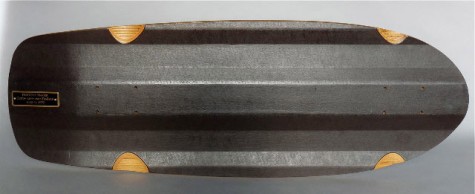

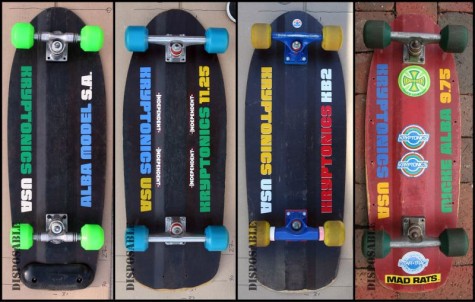
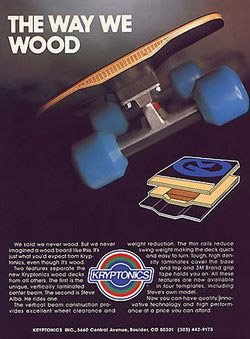
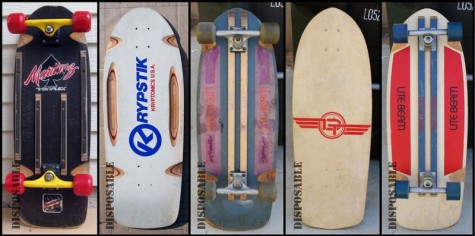
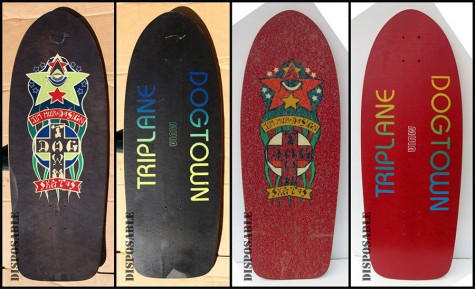
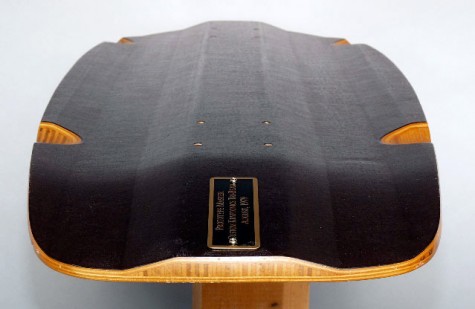
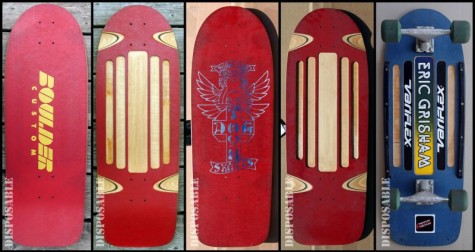
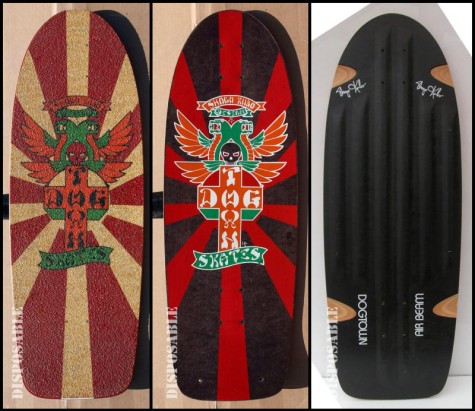


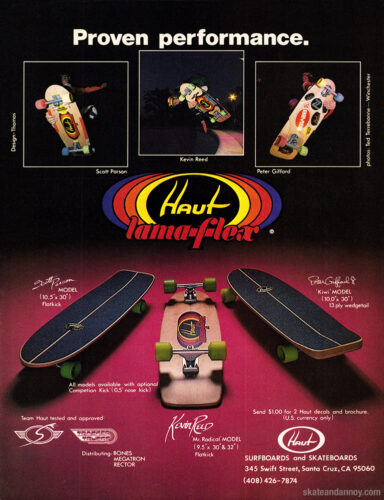
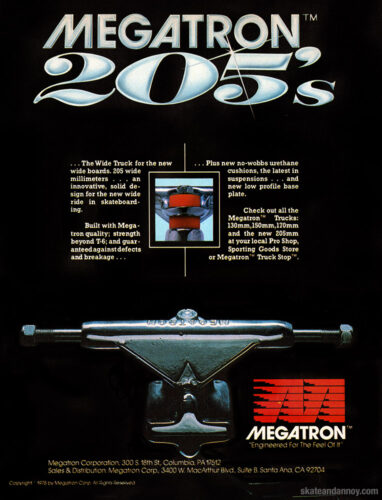






Interesting read. I don’t remember there being any
flex at all in my older bro’s K-Beam, but then again
I was just a little tike.
Who made Variflex’s boards after Boulder folded? They
kept using the Yorkite for a while.
Those boards were cool. I wonder if we’ll ever see alternative to current status quo of board construction. Maybe if people go back to riding mostly vert. I wonder how they would perform on the street.
Thanks that was a cool read. Slightly before my time, but interesting none the less.
Is there any standard shape major brands doing anything nearly that technical these days? Lib Tech is the only one I can think of, but they’re not really a major name in the skate industry.
I think modern concaves have pretty much rendered these technologies useless. Still fascinating to me though. There is that company making kevlar or carbon fiber vert decks. They have waht looks like routing on the bottom, but in actuality is just raised areas, kind of like these beamers. Almost or Enjoi or one of those guys makes boards with circuar inserts laminated over the truck areas… I think skateboards for your average street and bowl rider will remain fine just made out of cnandian maple. If they could make bamboo work in a short board that would be great from a sustainability standpoint. People keep threatening to send some in for review but they never show up.
Great piece of history, when function stood on par with form …
My husband, Don Dyer, worked at Boulder Boards the winter of ’78-’79. I remember going to the local skate park and watching a teenager test your boards. After watching the documentary about the Dog Town boys I always wondered if he was one of them. Don says Hello and was sad to find out the company is no longer in business. He would love to hear from you. Linda
Jim Ford handed me a Tribeam prototype in 1979. It was the absolute best board I had ever owned. How I wish I still had it. I knew at the time it was something special and have never seen another until I read this story.
I skated the Boulder Hi-Roller park on a daily basis. I am sure many of us have crossed paths!
Just picked up and unused Boulder KBeam at a thrift store just outside of Boulder!!
jordan send a pic of the k beam
I worked at Boulder Boards in 1979 for Ken and met Scott a few times. The wheel wells were signature for the boards they were making at that time.
Somehow, Scott was also hooked to Banana’s and Sebastian’s restaurants in Boulder and Fort Collins if I remember correctly.
What happened to Ken Clarke? We had some good times both working and playing.
Ken and Jan Clarke moved back to the Bay Area and started a custom cabinet shop call Eurowood Custom Cabinetry. We are still in business after 30 years and have raised 2 great kids. That was a roller coaster time of life living in Boulder. Boulder Boards was way ahead of its time.
I just came across a K-Beam that’s been sitting in a garage for the past 30 years. It’s definitely been used but graphics and deck look good. I believe it’s the tri-beam model. It has Independent trucks and Variflex wheels on it.
I’m interested in selling it so email me for pics and shoot me an offer as I’m already getting bombarded by emails for it. I’m just more into vintage hot rods these days. my email is firefocus@hotmail.com
I have an original Shogo Kubo Airbeam complete with tracker extrack trucks and Sims Snake wheels all in good riding condition. I will be posting on ebay soon .
http://www.ebay.com/itm/321094891149?ssPageName=STRK:MESELX:IT&_trksid=p3984.m1555.l2649
Not sure if anyone else experienced this but my shogo airbeam gradually became concave, the truck bolt’s would loosen of gradually and when id tighten them up it would kind of pull the edges of the deck upward, they would then gradually loosen off again and the cycle would continue.
It wasn’t so much a curve as a kind of angular concave.
Likw this but a lot less exaggerated. \_/
Loved that deck.
What a FANTASTIC read! I was living and skating in Colorado Springs during this period as a junior high/ high school student. We had THREE parks in the springs back then (Up the Wall, Earth Surfer, and one I cannot remember the name of). I rode on two of the teams (everyone called me “Whoop” back then). Anyway, it was GREAT being a part of the bigger/wider movement. My first “real” board was a 29″ G&S Fiberflex with Bennett Ad-Tracs and OJ’s. My friends and I used to take the bus to denver for five bucks, then transfer to the bus to Boulder for FIFTY CENTS and get dropped off at the park. As the home to both Kryptonics (which we all rode by this point) and Boulder Boards we treated this place with reverence. Ultimately, I got to reap the benefits of ALL of this inovation. I owned an Eric Grisham Pro Model Variflex, Owned an original KrypStick, Had a Shogo Kubo pro model and a Micke Alba pro model. By then we all were using Tracker Six Tracks or Indy 169’s. Again: THANKS FOR THE MEMORIES!!!! I’m 52 years old now and still own a vintage SMA Natas Pro Model with “asphalt” six-tracks and CrossBones and a 47″ Gravity Freeride longboard with 169’s and Kryptonics “red” 70’s.
PS: The original, BAD ASS, skatepark in Boulder back in the late 1970’s was called “High Roller”. I was there many, many times when the pros were skating. I was there in, I think, 1979 when they had a big pro meet and all the Sims, Dogtown (Alva), Kryptonics, and Variflex guys were there. I will NEVER forget the first time I saw Shogo Kubo ride the bowl. Eric Grisham gave me one of his pro-model blanks at that meet. I think I was 16 years old then
Wow, that was an excellent read! I had an SA K-Beam and then Shogo Airbeam around 1979/80. I had no idea they originated from the same manufacturer until now. There sure was a lot of innovation and experimenting in that era from maybe 1977-1981, coincidentally my favourite era for music!
One would have thought that 40+ years hence, board technology would have advanced to something unthinkable back then, but here we are with a simple variation.
Very interesting story! ?
Happy to own a good old Shogo Airbeam
Emojis obviously turned into question marks
I had a Shogo Airbeam back in the day, cannot remember what happened to it? Of course concave became necessary and flat boards were very quickly rendered obsolete. I wish there was more innovation with park/bowl/pool boards these days…
Rayne is doing some interesting things, I love their “fat bottom” construction on my DH longboard, which owes something to the original K Beam…
It is too bad these type of boards are so hard to manufacture, a “beam” style laminate with modern concave would be really cool!